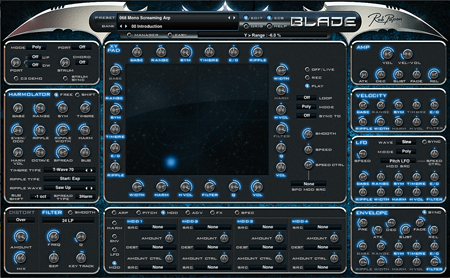Blade Review
Could Rob Papen’s new baby be another contender for the additive synthesis crown? Liam O’Mullane checks it out.

Software synthesizers aren’t exactly in short supply these days, and additive synthesis is looking to be a new trend, with companies such as Native Instruments and Image Line already having recently released AS-based instruments. These all aim to offer the complexity of AS but via a user-friendly interface. Following in this vein is Rob Papen’s Blade, which promises all of the unique possibilities of AS, but from a much more typical synth-style layout.

First Approach
Other easy-to-understand parameters are the Base dial (which sets the fundamental frequency for the sound), the Range control (this sets how wide the harmonics are around this Base frequency) and the Symmetry control, which moves a weighting bias so more harmonics are created above or below the Base.
Timbre enables you impose tones from a large range of presets. Sadly, this is one of the menus that you can’t simply flick through, making auditioning timbres a pain (click to open, move to a sub-menu and click a preset). It doesn’t make for very fluid workflow, but Rob has said that this is something he can look into in the future.
The rest of the nine parameters, along with a sub-oscillator, make this initial point of sound design simple to explore, craft and, most importantly, understand in terms of how you’re getting your sounds.
Adding It Up
Although there’s a lot of sonic range available from the Harmolator alone, we love the distortion and effect stages of Blade. They sound really good and we managed to sculpt a lot of mix-ready synth sounds using them alone. This not only means that Blade is good value for money in this respect, but it also makes the modulate-any-parameter functionality a very creative prospect. We only wish there were a few more effect slots than the two featured, giving more sonic possibilities.
It’s hard not to notice the large X/Y controller in the centre of Blade’s GUI. The strips of parameters that surround it allow you to assign elements of the Harmolator for movement over time.
A unique feature on the X/Y pad is the ability to record your movements with the mouse or a controller. This is stored and you can have it re-triggered just like any ordinary envelope or LFO. This is especially useful for pad and soundscape design, when you want less rhythmic and more varied modulation movements over a longer period of time.
You can also change the speed of your recordings, so fast and more aggressive rhythms are easier to achieve, although you can edit the content of a recording and even loop them in a few different ways. You can’t (yet) change the start or end points, though, which doesn’t maximise on this recording feature’s potential.
In terms of the usual modulation options, regular LFOs, envelopes and other modulation tools are all present and correct. We like the way that any parameter can be muted simply by clicking its name – a small but very handy feature when you’re trialling potential options on a sound.
In general, Blade is an additive synth that has the look and feel of the more familiar layout of a subtractive synth. It is easy to pick up and learn and the modulation options help you to make highly expressive and original sounds with ease.
Verdict
+ Very easy to understand
+ Great sound quality
+ X/Y-record is handy
– X/Y movement recording can’t be edited as yet
– Some menus are pop-up and click-only (no scroll buttons)
A powerful yet easy-to-use additive synthesizer with great FX and distortion. Good for pads, leads, basses and more.
9/10



